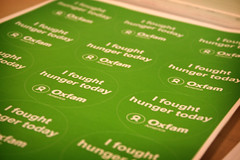 Salem's commitment to ending hunger --- one sticker deep at most. Image by ginnerobot via Flickr
Salem's commitment to ending hunger --- one sticker deep at most. Image by ginnerobot via Flickr
If climate change and population growth progress at their current pace, in roughly 50 years farming as we know it will no longer exist. This means that the majority of people could soon be without enough food or water. . . .
The floods and droughts that have come with climate change are wreaking havoc on traditional farmland. Three recent floods (in 1993, 2007 and 2008) cost the United States billions of dollars in lost crops, with even more devastating losses in topsoil. Changes in rain patterns and temperature could diminish India's agricultural output by 30 percent by the end of the century.
What's more, population increases will soon cause our farmers to run out of land. The amount of arable land per person decreased from about an acre in 1970 to roughly half an acre in 2000 and is projected to decline to about a third of an acre by 2050, according to the United Nations. With billions more people on the way, before we know it the traditional soil-based farming model developed over the last 12,000 years will no longer be a sustainable option.
Irrigation now claims some 70 percent of the fresh water that we use. After applying this water to crops, the excess agricultural runoff, contaminated with silt, pesticides, herbicides and fertilizers, is unfit for reuse. The developed world must find new agricultural approaches before the world's hungriest come knocking on its door for a glass of clean water and a plate of disease-free rice and beans. . . .

![Reblog this post [with Zemanta]](http://img.zemanta.com/reblog_e.png?x-id=8058980d-7de9-4442-b96a-d81681ce41a6)

![Reblog this post [with Zemanta]](http://img.zemanta.com/reblog_e.png?x-id=2c458de5-725a-4630-92ec-92213f2b3d97)



